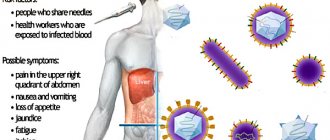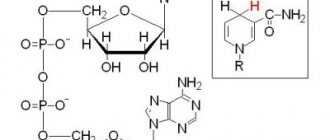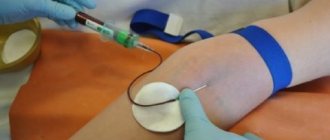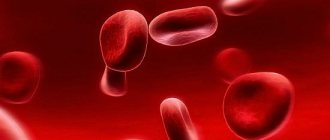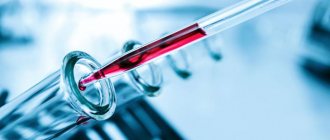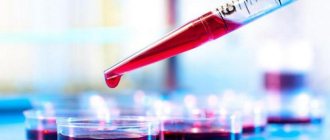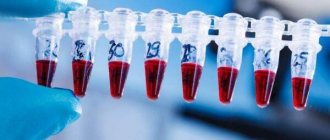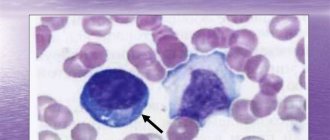When is OAC prescribed?
A specialist prescribes a blood test to identify an infection in the body (including viral), inflammation or neoplasm that is malignant in nature. Thanks to a general clinical analysis of plasma, it is possible to assess the effectiveness of the prescribed and administered treatment for the patient.
OAC is also mandatory for pregnant women.
Summarizing the above, we can identify the main reasons for taking a clinical blood test:
- Prevention . It is carried out once every 6 or 12 months. Allows you to identify the disease at the initial stage of its development.
- Diagnostics . The work of the heart, lungs, kidneys, and liver is studied. The infection of the body is determined.
- Study of blood pathologies . For example, anemia and its type are determined and, if necessary, an additional study is prescribed, a sterile puncture from the sternum.
- Control . Hemoglobin and platelet count in pregnant women.
The primary general analysis does not have to be taken on an empty stomach. This requirement is only when taking a biochemical and detailed blood test.
What diseases can be detected using OAC?
When studying blood, a general analysis reveals a variety of types of ailments - leukemia, autoimmune diseases, poisoning of various etiologies, traumatic lesions of internal organs, infectious invasions of various types (viral, bacterial, protozoa, fungal, helminthic). Blood is a liquid tissue that circulates throughout the body. In total, an adult contains from 4.2 to 5 liters of blood. A full cycle of blood circulation is 55-70 heart beats. In a day, a person is able to pump 8500-10000 liters of blood through the heart. By washing the body's tissues, the blood changes its composition, thanks to which it can serve as a universal marker of health.
A general analysis is not an exact study. Its goal is to provide some generalized data about the physiological state of a person. For example, if the level of leukocytes in the blood has sharply increased, this will be a likely sign of an infectious lesion, but a general analysis will not answer the question: “What kind of infection caused the increase in the level of white cells in the blood?” What the general blood test reveals will be information for further research.
Before the advent of biochemical blood test (BAC) and polymerase chain reaction (PCR), diagnosticians used a complex system of combining the results of various clinical examination methods - temperature measurement, complete blood count, visual examination, bacterial culture. This system remains relevant today. LHC can easily determine which organ is affected by the disease, and PCR clearly identifies any type of infection.
Should I take a general blood test on an empty stomach or not?
The procedure is carried out in the morning and always on an empty stomach, otherwise the indicators may not be entirely accurate. During the day, under the influence of various factors (food, physical activity), blood counts change. That is why doctors recommend taking tests in the morning and always on an empty stomach.
To get an extremely accurate result you should:
- Food on the eve of the test can be taken until 20.00.
- Fatty foods and alcohol should be excluded from the diet 3 days before the test.
- Refrain from smoking, tea, coffee, sugar, because The indicators may be distorted, which will require the analysis to be repeated.
- Stop taking any medications. If this is not possible, you should consult a doctor.
- You should not take a blood test after procedures such as massage, x-rays, ultrasound, etc.
It is advisable to follow the described recommendations within 24 hours before taking the tests.
The only thing you can do immediately before taking the test is drink still water.
As for infants, the preparation conditions remain the same - in the morning and on an empty stomach. If the situation is urgent and requires quick results, then these recommendations can be neglected.
What diseases can be detected by a blood test?
A blood test shows doctors all hidden diseases, including cancer
“The diagnosis is based on collecting information about the patient, detecting characteristic signs and laboratory tests,” notes Berd doctor Ekaterina Miguleva. — Using a blood test, a doctor can diagnose the disease at an early stage or refute it.
Today you can’t go without a blood test.
The main tests are: • general blood test • biochemical analysis • blood sugar test • hormonal profile analysis • blood test for tumor markers
What's in your blood?
A decrease or increase in the level of blood components in a general analysis indicates certain disorders in the body. Let's look at the main ones. A decrease in hemoglobin may indicate hidden bleeding, unbalanced nutrition and helminthic infestations. Its increase may indicate respiratory pathology.
A low red blood cell count indicates chronic inflammation. This can also signal cancer processes and autoimmune pathology. Taking certain medications can cause a decrease in this indicator. Platelets are involved in the process of blood clotting. They prevent blood loss during injuries and damage. Their decrease indicates a clotting disorder and a lack of certain vitamins, such as B and D. Low or, conversely, high levels of this blood element indicate the presence of infections and malignant neoplasms in the body.
Leukocytes are soldiers of the immune system. Often their increase indicates intoxication or allergies. Liver diseases, such as cirrhosis, cause an increase in white blood cell levels. Prolonged, exhausting physical activity can also increase them. A decrease in white blood cells often occurs with viral infections. ESR (erythrocyte sedimentation rate) is an important indicator. It increases with inflammation, chronic infectious diseases and allergies. Its increase may be a consequence of high blood cholesterol and the use of oral contraceptives.
How often should you donate blood?
Even if nothing worries you, take a general blood test and blood glucose test once a year. Both tests are performed on an empty stomach.
For infertility and impotence
Hormones are chemical compounds produced in the glands of the body's endocrine system. The coordinated work of all organs and systems depends on their normal indicators. What are the types of blood tests for hormones? • Analysis of female hormones • Analysis of male hormones • Tests for thyroid hormones
The doctor prescribes a test for female hormones if there is a suspicion of infertility, menstrual irregularities, or the use of hormonal medications. An analysis of male hormones allows you to identify problems with potency and determine the cause of infertility and prostatitis.
“The Novosibirsk region is a zone of so-called iodine deficiency, so blood tests for thyroid hormones are of utmost importance,” notes Dr. Migulyova. “They will allow the doctor to assess the functions of the thyroid gland and make the correct diagnosis.
Catch cancer
Tumor markers are a real breakthrough in medicine; they make it possible to identify this terrible disease in the early stages. The doctor prescribes this test if benign or malignant tumors are suspected. For example, if PSA (prostate specific antigen) is elevated in a tumor marker, this may indicate adenoma or prostate cancer. Deviations from the norm in CA 125 indicate tumor diseases of the ovaries, cervix, mammary glands and pancreas.
In addition to the above blood parameters, every citizen must take a test for blood type and Rh factor. This test is mandatory before operations, before hospitalization and during pregnancy. There are 4 main blood groups. The first one is the most common. This is a universal blood group, which in emergency cases can be transfused to patients with other groups. The rarest blood group is fourth. According to statistics, it occurs in 10% of the population.
• The human body contains about 0.2 mg of gold, most of which is found in the blood.
• The human heart pumps 10 thousand liters of blood per day.
Do you often donate blood?
Complete blood count: what is studied
Let's consider what is determined during OAC and the main meanings of the data obtained.
Red blood cells
Increased cells indicate:
- oxygen starvation,
- disturbance of water-salt balance or dehydration in the body; erythremia;
- heart disease (after suffering a complex form of infectious disease);
- impaired functioning of the adrenal cortex;
- overdose of glucocorticosteroids.
A low hematocrit “speaks” of:
- anemia (iron deficiency type);
- pregnancy (2-3 trimester);
- decreased concentration of circulating blood;
- inflammation.
Different meanings
Hemoglobin is a blood pigment found in red blood cells. It carries oxygen from the lungs to organs, tissues and removes carbon dioxide. Its level is important for determining anemia. With illness, it will decrease (normal values for women are 105-155 g/l, for men - 125-170 g/l).
An increase in hemoglobin is characteristic of erythremia, erythrocytosis, cardiopulmonary failure, and congenital heart defects. With serious blood loss, a catastrophic decrease occurs. The minimum pigment content for life is 10 g/l.
Indicators and deviations from the norm
| What are they checking? | What does a deviation from the norm indicate? |
| Leukocytes , so-called white blood cells, protect the body from attacks by bacteria, viruses and allergens, cleanse the body of altered or damaged body cells | The number of leukocytes increases during inflammatory processes, and it matters due to which leukocytes their total number is increased. For example, an increase in the number of neutrophils is typical for bacterial infections, lymphocytes for viral infections. |
| Eosinophils are a type of white blood cell that protects the body from parasites and is involved in the development of allergic reactions. | The number of eosinophils increases in allergic diseases or parasitic infections |
| Basophils - support blood flow in small vessels and effectively influence the growth of new capillaries | An increase in basophils in the blood may be a reaction to the administration of a drug, indicate an inflammatory process, an allergic reaction, or the onset of menstruation |
| Atypical mononuclear cells, pathological forms of leukocytes not found normally | Their presence is characteristic of mononucleosis and some other viral infections |
| Erythrocytes are red blood cells that contain hemoglobin, which binds oxygen in the lungs and transports it to the tissues | An increase in their number may be associated with disorders that do not pose a health hazard and indicate dehydration, erythremia, chronic leukemia |
| Platelets are small, anucleate cells responsible for blood clotting. | Their number increases with inflammatory diseases and anemia; a decrease is possible during pregnancy, viral infections or as a reaction to taking medications |
| ESR - erythrocyte sedimentation rate - indicates a change in the general condition of the body exposed to toxic effects | ESR increases during inflammatory processes, during the recovery period after infectious diseases. It may remain elevated for a couple of weeks after recovery. |
| Hemoglobin is a protein that transports oxygen to tissues | A decrease in its concentration indicates anemia. Increased for diabetes mellitus, intestinal obstruction, some heart and lung diseases. Also increases with burns and dehydration |
Evgenia Kaznacheeva, clinical laboratory diagnostics doctor, head of the general clinical research laboratory of the clinical diagnostic laboratory "Invitro - Moscow"
